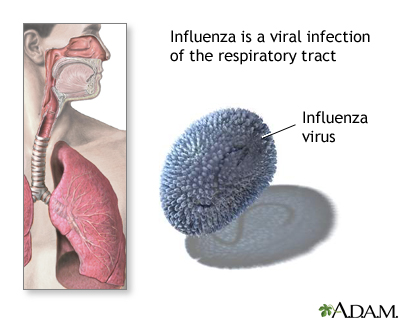Meningitis - H. influenzae
Haemophilus influenza organism

This picture shows the organism Haemophilus influenza. Infections caused by Haemophilus influenza usually occur in children under 6 years old and are extremely serious. Haemophilus (type B) is responsible for meningitis, periorbital cellulitis, buccal cellulitis and epiglottitis, septic arthritis, osteomyelitis, pericarditis, and bacteremia. The small organisms live within cells (intracellular) as shown in this picture. (Image courtesy of the Centers for Disease Control and Prevention.)
Influenza

Influenza, also known as the flu, is caused by a virus.
Haemophilus influenzae meningitis is an infection of the membranes covering the brain and spinal cord (meninges) caused by H. influenzae bacteria.
Haemophilus influenzae type B (Hib) is a type of bacteria, not to be confused with the disease influenza , an upper respiratory infection caused by the influenza virus. Prior to the availability of the Hib vaccine, H. influenzae was the leading cause of bacterial meningitis in children under 5 years of age.It occurred most frequently in children from 1 month up to 4 years, with a peak at 6 to 9 months. Since the introduction of the vaccine in the U.S., H. influenzae now occurs in less than 2 in 100,000 children. It still causes between 5% - 10% of bacterial meningitis cases in adults. H. influenzae meningitis may follow an upper respiratory infection, and may develop slowly or quickly. The infection usually spreads from the respiratory tract to the bloodstream, and then to the meninges. At the meninges, the bacteria produce infection and inflammation, causing serious illness and sometimes death. Risk factors include a recent history of otitis media (ear infection), sinusitis (infection of sinuses), pharyngitis (sore throat), other upper respiratory infection, or a history of a family member with an H. influenzae infection. Another significant risk factor is race -- Native Americans have a rate of more than 3 times that of the general population. Placement in day care also increases risk.
No comments:
Post a Comment